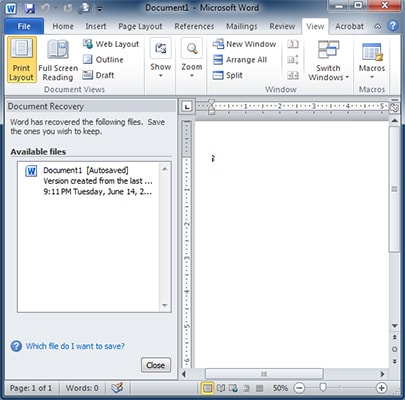There are times for all computer users when you just want to go back in time. You want to recover some words of wisdom from a past draft, or perhaps a file was deleted or lost in the ether. Just today there’s a story in the about an author who lost his entire 113,000 word novel (a Microsoft Word document) and had to recover it from emails, PDF and memory.
Microsoft Word allows you to make an automatic backup of your working document. If the program crashes or your computer accidentally loses power, the AutoRecover feature will attempt to load the most up-to-date version of your document. Microsoft Office 2016 - Unmistakably Office, designed for Mac. The new versions of Word, Excel, PowerPoint, Outlook, and OneNote provide the best of both worlds for Mac users - the familiar Office experience paired with the best of Mac.
You can avoid the same fate with some simple and mostly automatic options buried in Office, Windows and elsewhere. They’ll let you can recover what you thought was lost forever. If Word or the computer crashes, restart Word are you’ll be given the option to restore the document from the last Autosave point. Backup copy In Options| Advanced| Save (scroll down to find it) you’ll find the ‘Always create backup copy’ option that many people thought was lost. This very handy option saves the document you’re working on and the version prior to the most recent save. The most recent changes aren’t in the backup copy. In other words, if you save Sherlock.docx, Word will also save Sherlock.WBK which is the current document less the most recent changes.

Backup documents are saved in the same folder and document name but with a.WBK extension. Despite the extension, they are standard DOC, DOCX etc files. Copy remotely stored files onto your computer Not strictly a backup option but worth mentioning. If you open a document from a remote location (meaning a network share or removable disk, USB stick etc.) Word will normally work with the document from that location.
That can slow down Word, depending on the speed of the connection. It adds slightly more risk in saving if the connection to the remote location breaks (the network stops or disk is removed).

To protect against that, choose ‘Copy remotely stored files onto your computer’. This will keep a temporary copy of the file on your computer.
If there’s a problem saving remotely, Word will be able to recover from the copy on your computer. We suggest turning this option ON. The main reason to keep off is document confidentiality. Tracking Word and Excel have comprehensive tracking, comment and review features under the ‘Review’ tab. These features let many people to collaborate on a document but also serve as a form of backup. With ‘Track Changes’ set on (at Review| Track Changes), Word will keep all additions and deletions to the document. Set to ‘No Markup’ so the document changes don’t clutter up your screen.
If you need to recover deleted text or objects, turn on Markup so you can see and restore anything put into the document. What’s missing Over time, Microsoft has dropped some features from Office that were useful in recovering past versions of documents. The usual reason for dropping a feature is that it’s not used by many people. Too often, it’s really to reduce development costs inside the Office team. Backup documents WBK Some people think that saving.WBK files was dropped from Word. It’s still there (see above) but buried in the Advanced settings and default OFF. Versioning Word did have in-built version control.
It could be set to keep the last n saved versions of a document. That was dropped from Word since 2007. ‘Always create backup copy’ is still in Word and saves one past version but no more. Create bootable image file. Word’s versioning was dropped because Windows has similar features. Windows 7 has ‘Previous Versions’ where past copies of a document are saved with Window Backup. Right-click on a file and choose the ‘Previous Versions’ tab to see past versions. Window 8 and Windows 10 have ‘File History’ which is a vast improvement.
It’s similar to Apple’s Time Machine and takes a ‘snapshot’ of changed files on your computer. It’s so important we devoted 20 pages to File History in starting on page 254. Versions in cloud storage Some cloud storage services will automatically save past versions of a file.
It’s similar to File History in Windows 8/10. OneDrive Microsoft’s OneDrive keeps versions of Office documents only. In the browser view of your OneDrive files, right-click on a document and select ‘Version History’. OneDrive for Business Despite the similar name ‘OneDrive for Business’ is quite different. It’s essentially SharePoint and so it has not only versioning but also Content Approval, Tasks and other collaboration features. Dropbox Dropbox will keep past versions of files for 30 days.

 0 kommentar(er)
0 kommentar(er)
